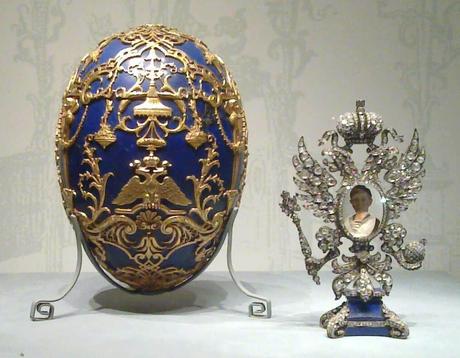

Magnificent Lapis Lazuli. I always wonder how someone can create such heavenly pieces of art. Here I will talk about the marvelous magical objects wonderful hands have made through time.. I will tell you about its use in the Persian and Roman Empire; the Renaissance and the Modern World. The magnificent works of the famous Pietra Dura. The artistic wonders of Lapis Lazuli (lapis for short). Enjoy!
Ancient Civilizations
Lapis Lazuli is a semi precious stone which appears in the most ancient civilizations known to man. Neolithic men were the first who created the first jewelry. They would bore a small hole through the Lapis Lazuli and string the pebbles of blue with a thread.
4,000 years ago, artists created objects like cylinder seals, necklaces. They also made amulets, animal statuettes and inlay on important statues, mostly in the eyes it absorbs all attention to the figure.
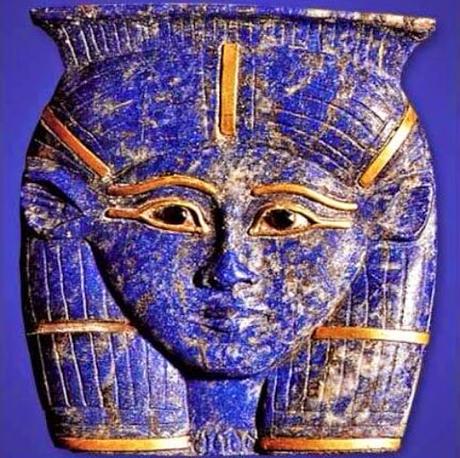
It had such an importance in life as well in the after life. Prove of that is that Lapis Lazuli was also found in Neolithic tombs in Mauritania and in the Caucasus. The wealthiest tombs of the first dynasties had lapis. The Egyptians listed it in their funeral items and also used it at the tomb of Pharaoh Tutankhamen.
Ancient kings demanded lapis for royal workshops which fashioned many pieces for daily living in lapis including parches boards and talismans as symbols of truth.The first land vehicle is a queens sledge with lapis from 2100B.C., an interesting fact that made my day. The Sumerian of ancient times created necklaces, belts, headdress, as well as finery, combs and tiaras.
The Palace walls in the Cretan Palace of Knossos from 2000B.C showed how the pulverized stone was mixed to form a blue pigment for painting.

Priests bordered Ecclesiastic Manuscripts with crushed pigment. Artisan painters also used Lapis for religious shrines and decorative elements on the altars of churches.
Persians
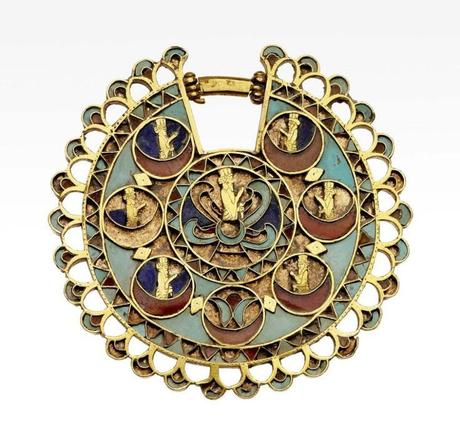
The Persians controlled the flow of lapis from antiquity. Their art presented itself in the painting of miniatures like Layla and Majnun, Shirin and Khosrav painting and specially the manuscripts of the poet Nizani (1140-1202 A.D). Persian art, especially served two purposes; it inspired beauty and often provided a practical use in vases, containers and also in personal art. These artisans spent their lives grinding pigments by pulverizing minerals. There were various shades of Lapis Lazuli as pale blue, azure and greenish blue.
Roman Empire
Roman Emperor Augustus wife, Livia, in 1A.D was immortalized in a Lapis figurine carved of her face and affixed to a gold cross. It was a gift to Archbishop Herriman of Cologne. Emperor Augustus was one of the founders of the silk route. The silk route connected trade across Asia and he ruled Rome from 100-44 B.C. He was also the grandnephew to Caesar.
Roman Legionnaires wore seal ring set with gemstones. On his deathbed, Napoleon Bonaparte gave his son a signet ring of lapis. It was a token of love. The Roman practice of wearing seal rings continued and became a tradition. This style began in antiquity and merged into western lifestyle. To acquire an elegant and stylish Lapis Lazuli ring you only have to visit our favorite Nammu store.
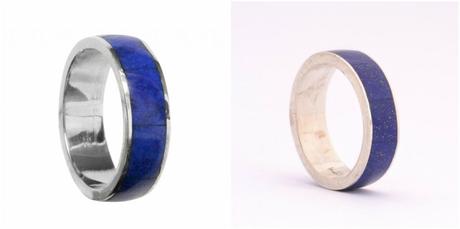
Pliny the Elder, a scholar of repute, called lapis a star rock for its gold pyrite flecks.
A fragment of the starry firmament - Pliny The Elder
Click To Tweet
Throughout the Latin speaking Roman World the word “sapphirus” was used when they were really referring to Lapis Lazuli.
Roman Healers
The Romans also employed lapis in the treatment of circulatory diseases, epilepsy and skin troubles. They also used it as an aphrodisiac and who knows maybe they still do. They used lapis earrings, bracelets and hypnotizing pendants.
Roman artists also immortalized in 1 A.D., the wife of Roman Emperor Augustus, Livia, in a Lapis Lazuli figurine. Livia’s face was carved and affixed to a gold cross.
In the Salle du Tresors in Paris at the Louvre are fine examples of lapis like the manuscripts of Chantilly where the French also used it as pigment applied to the pages.

Renaissance
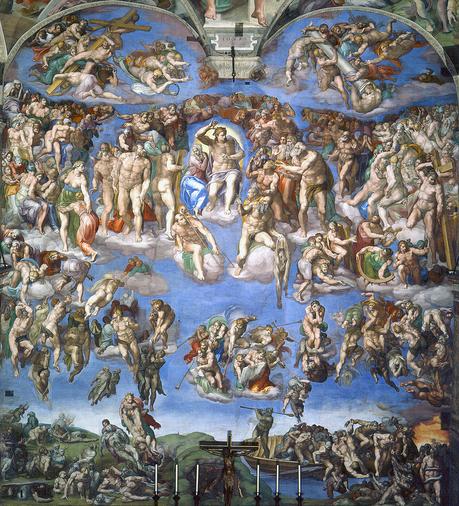
Renaissance! Literally the rebirth. I’ve talked before of Lapis Lazuli and its artistic uses but I deemed necessary to dedicate an exclusive post to its use by the master artisans of the Renaissance and what it meant to the Roman culture. Who hasn’t seen pictures of Michelangelo’s work in the Sistine Chapel or Leonardo da Vinci’s? Lapis Lazuli Azzurro is a formidably example of heavenly craftsmanship.
I particularly had the incredible opportunity to admire in first hand the Sistine Chapel. I remember I used to get lost in the blueness of the heavens without realizing at the time that I was also admiring another piece of work in its self, the beautiful and unique Lapis Lazuli.
Artisans and painters from the ancient Rome, also used Lapis for religious shrines and decorative on the altars of churches.
In the Salle du Tresors in Paris at the Louvre are fine examples of lapis like the manuscripts of Chantilly where the French used it as pigments applied to the pages. Due to the frailness of the manuscripts one must wear a mask and turn the pages with wooden sticks to prevent decomposition.
In the Renaissance it was more expensive than gold. Michelangelo’s pigments included Lapis Lazuli for the Sistine Chapel (1475-1564). The Sistine Chapel is by far is one of the most exquisite uses of lapis pigment for the blues of heaven where the best stones were required.
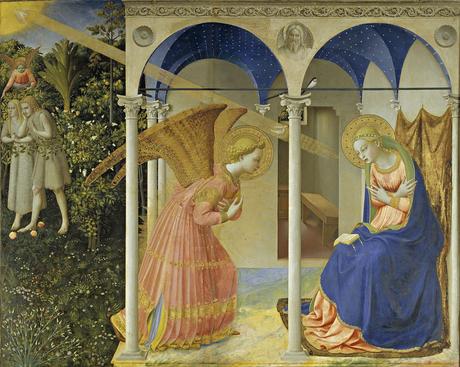
Leonardo da Vinci, Fran Angelico and other master artists also wanted the mineral for pigments. They usually reserved lapis for the cloaks of Christ, Angels and especially the Virgin Mary.
During the Renaissance, the Medici of Florence, the prominent Italian banking family, also provided decorative stones to artists like Benevuto Celli and other master artists.
It was a mark of wealth to commission a painting specifying the use of lapis.

Church
The Church also valued and esteemed beyond measure the decorative beauty of the chapels. So the purchase of colorants was very important under the pontiff Clement VI, 1342-1352. He directed the painting of the Chapel St. Michel, the Chapel St. Martial and the Chapel of St. Jean. For the Chapel of Avignon, France, Clement VI chose Italian artists from the Siennoise School directed by Matteo Giovanetti de Vitero. He was the official painter of many popes.
In the Renaissance the Goths of Europe migrated from the Near east to workshops of European artisans.
The paintings made during the renaissance used lapis until J.B Guimet, in 1826, discovered a method to synthesize and prepare a blue pigment in large quantities at a lower price.
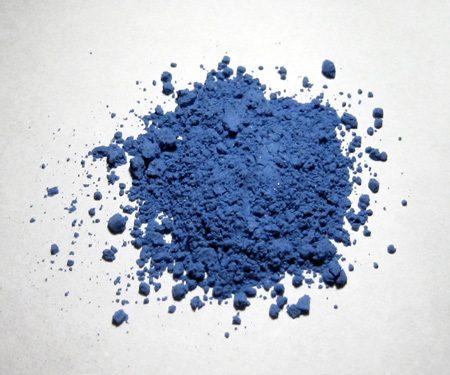
The artisans obtained pigment powder by crushing, calcinating and red heating the lapis and then immerse it on water
The artists also treated the powder with acetic acid to dissolve the carbonates. Only a small amount, about two to three percent of the start up material, produced the final pigment. When lapis pigment
Florence
Pietra Dura

The Grand Duke of Tuscany, Cosimo de´Medici and his two sons were the ones in charge of spreading the techniques of hard stone carving in its various forms all over Europe.
The stones, Lapis Lazuli included, were used for free-standing vessels, for hard stone inlay as in commesso di pietre dure, for intarsio (the jigsaw like inlay techniques) for scagliola, pressing the powdered minerals into designs incised in slabs of marble or a hardened compound of powdered marble and glue.
Examples of Medici hard stone patronage are all over Florence in more secular settings. Massive cabinets set with panels of elaborate pietra dura were created to accommodate the Medici passion for collecting. Cupboards, drawers, secret drawers could be stuffed with precious stones ancient and modern, sometimes worked by Florentine craftsmen. In the panels the brilliant blue of Lapis Lazuli was used to re-create extravant wreaths of morning glory, bright-hued birds in branches, in borders and in frames. Cost was clearly irrelevant to these Medici patrons.
When Ferdinando, son of Cosimo, took over the family, he dispatched vessels of pietra dura all around Europe to reinforce major diplomatic moves including marriages. The prestige of the family was his main concern.
Opificio delle Pietre Dure
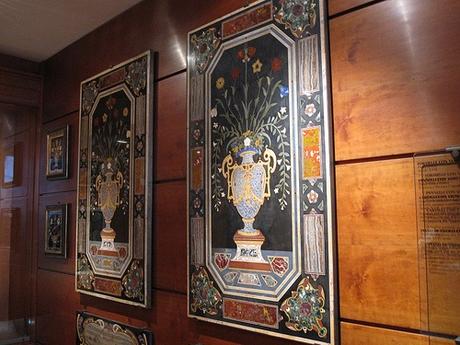
Laminated Lapis Lazuli cut with the finest of saws was used extensively in the strange landscapes favored by Ferdinando. The tool is an elegant bow-like artifact with six strands of fine horsehair to cut lamina from lumps of stone.
Flecked with calcite lapis is ideal for skies, seas or distant mountains. There is a “Tuscan landscape” in the Opificio Museum with an expanse of lapis sky. Another has distant lapis mountains and a lapis clothed angel coming to Elias who has a handsome lapis water jar at his feet.
Some of these laminated plaques were incorporated into pieces of furniture.
Nowadays, this workshop still uses the traditional tools for stone carvings. Today they are wielded by smart young women conserving, restoring or actually creating other works of art and craft.
It has a courtyard with a big pile of Lapis Lazuli…
Modern World
The incredible workshops of Peter Carl Faberge in Russia also had access to Lapis Lazuli and fashioned one of the 58 grand Imperial Eggs for Czar Nicholas II in that material. It was a gift to his wife, the Czarina Alexandra Feodorovna on Easter Day 1912. The image of their eight year old son Alexis was the surprise inside the egg. The frame was on top of a Lapis Lazuli base. It’s on display at the Virginia Museum of Art in Richmond. The most recent sell of an Imperial Egg was in 2007 at Christies for 18.5 million dollars.

Salvador Dali also designed sculptured jewels in artistic forms with Lapis Lazuli.
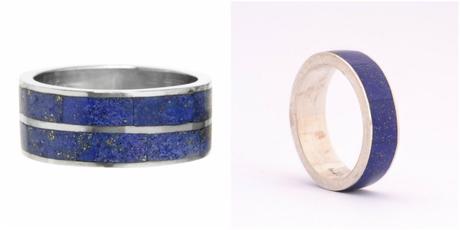
Experts in Idar-Oberstein use lasers to cut beautiful pieces. Lapis is also used for cuff links, pendants, and earrings, rings. Lapis is also set into watch faces, and inlaid onto clocks or for marquetry on fine woods. Carvings can also be found in fine stones particularly in Hong Kong and mainland China where they are worked more exquisitely than anywhere in the world.
Incredible all the beautiful things people through history have made with Lapis. I can keep writing for days about this fabulous stone. Lapis, a great contribution to humankind through art. Thankfully we can also acquire and have in are hands beautiful jewelry of Lapis Lazuli in my favorite Nammu store.
dried, its strength remained unchanged during the course of centuries.
This ancient formula lapis powder is still used today by museum conservators and forgers
Click To Tweet

We’ve seen Lapis Lazuli in all shapes and forms. Used in countless objects, jewelry, paintings and also for healing purposes. One incredible use of lapis that we have seen briefly is the Bible Writ on walls.
Lapis shines here and there in some remarkable wall paintings. For obvious reasons of expense (remember that in the old days, lapis was more expensive than gold) lapis lazuli pigment is used sparingly. Sometimes an undercoat of cheaper blue pigment such as the copper based azurite was used. Although in the eleventh and twelfth centuries we can find it occasionally even with great extravagance.
These wall paintings were an essential ingredient of a heavenly beauty designed to draw the eyes and feed the minds of a largely illiterate congregation as it circulates within the new church, highlighting the drama most usually of Old and New Testaments and also the lives of saints.
The only way of determine if lapis pigments was used on medieval wall paintings is with a proper analysis.
There were two methods of wall painting. One was used in the Renaissance Italy and involved plastering an area of wall that had to be decorated while the plaster was wet. The other was the traditional method used since at least the second millennium BC in India, Central Asia and in the Byzantine world. In this method the wall was painted when the plaster was virtually dry.
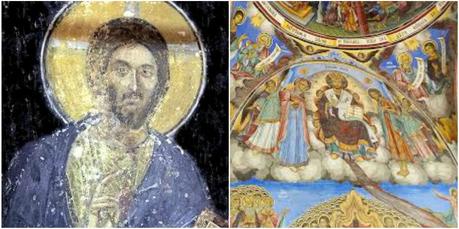
Traditional Method
The plaster should be laid in two thick layers and the pigments applied when the second layer was virtually dry. Walls were covered first with enough rough mud plaster with straw or hemp. The second layer was polished smooth before drying.
Benedictine monk Theophilus (twelfth century), described this method on his On Divers Arts, “when figures or birds or representations of other objects are drawn on a dry wall, the wall must be immediately sprinkled with water until it is quite wet. And all the colors which are to be put on must be mixed with lime”. In this case, Theophilus was wrong. Lapis Lazuli would have been bleached if mixed with lime.
The two crucial blues, Lapis Lazuli and azurite, were mixed only with water and only painted on completely dry plaster. Lapis was used moderately and frequently over the cheaper azurite to give extra brilliancy.
Most of the wall paintings that have survived from the Byzantine world are in more out of the way places than in the great metropolitan centres, like the Balkans, in the Gartempe valley in France, Burgundy, and also in Canterbury.
Here are some examples of these paintings.
Boyana Church
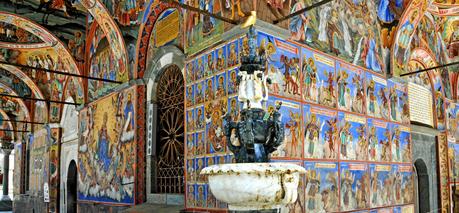
Located in the suburbs of Sofia below Mount Vitosha. It´s a tiny church that was founded in the eleventh century. It was enlarged in the mid-thirteenth century when the interior was decorated top to bottom with the most superb paintings.
It has around 240 scenes. There are the usual scenes of heaven and terrible hell as well as the life of Christ and his Mother, with her Dormition over the western door of the chapel. There is a Last Supper with Bulgarian staples, the lives of saints dressed in costumes of medieval Bulgaria, including the most popular St Nicholas. We can see fourteen scenes of his life including one of the most emblematic tales of his life, when he appears rescuing some sailors in the coast of Lycia. This storm scene allows for ample use of lapis pigment.
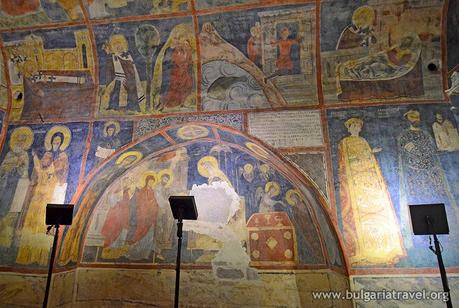
We can also see the Boyana patrons, Desislava and Sebastocrator Kaloyan.
Arbanasi
In the tiny Church of the Nativity we can also find martyrdoms and monsters, Old Testaments prophets and medieval heroes.
Church of Ayios Demetrios
Just off the Via Egnatia, this church has incredible wall paintings, especially the early fourteenth century dedicated to St. Euthymius. Here we can surely appreciate Lapis Lazuli highlighting the folds of the saints’ robes.
Church Of Ayios Nikolaus Orphanos
It has superb wall paintings about the bishop Nicholas. We can once again appreciate Saint Nicholas saving the sailors.
Church Sant’ Angelo de Formis
Founded in the late eleventh century by Abbot Desiderius. Every interior space is covered with paintings. No expense was in its decoration. A magnificent Christ in Majesty. Images of the Old and New Testaments decorate the walls of the nave for the benefit of the illiterate. The images exhale an austere Byzantine grandeur. Blue is everywhere the dominant color, the blue of Lapis Lazuli.
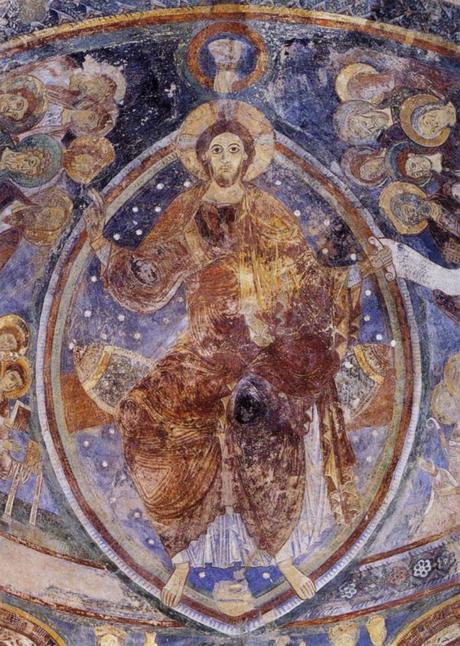
Located in Cluny, France. We can find Christ seated in Majesty, depicted as a four-meter tall Byzantine emperor within an almond shape mandala, symbol of the universe. He is painted against a background of pure Lapis Lazuli. The hand of God holds a crown over the head of Christ. Here, no expense was spared, no limit to the expenditure of Lapis Lazuli. Modern analysis has highlighted its abundant use.

Canterbury Cathedral
Here are the remains of a wall painting of a famous occasion in the Acts of the Apostols, in the life of St Paul.
St Paul was set against azure sky, the folds of his robe highlighted in ultramarine.
These are only a few of the places were you can encounter Lapis pigment in the most sublime sacred context, highlighting Christ and the Madonna in majesty, the terrifying apocalyptic world of revelation and the great consolation of Redemption.
Beautiful Lapis Lazuli that you can find in your favorite Nammu.com store.
Y hoped you enjoyed and learned as much as I did….
Present
Nowadays, this magical blue pigment obtained from Lapis Lazuli is mainly used in restoration work and by collectors of historical paintings.
It is simply incredible when you realize that this beautiful Lapis Lazuli was formed in the cataclysms of the earth sixty million years ago. And now we can enjoy it in the form of dazzling jewelry in Nammu.
In the Renaissance it was more expensive than gold. Michelangelo, Da Vinci, Fra Angelico and other master artists also wanted the mineral for pigment. Michelangelo also used pulverized Lapis Lazuli for the Sistine Chapel (1475-1564) . I discovered that it is by far one of the most exquisite uses of Lapis Lazuli as pigment for the blues of heaven therefore the best stones were required.

Thankfully for us, the blue color on canvas or frescoes prior to 1826 was Lapis Lazuli. I say thankfully, because lapis gives a painting a magical aura. The genius Leonardo Da Vinci also used Lapis Lazuli in his work. Artisans and painters reserved lapis for the cloaks of Christ, angels and specially the Virgin Mary.
In the mid 1800s artists and chemists began developing synthetic blue pigments for use as alternatives to ultramarine blue made from Lapis Lazuli. In 1824, The Societe d’Encouragement offered a prize of six thousand francs to anyone who could produce synthetic variety. After four years they gave the prize to Jean Baptiste Guimet who submitted a process he had developed in 1826.
The oldest mined gemstone on the planet is still sold throughout the world today
Click To Tweet
Modern Day Lapis Lazuli Uses
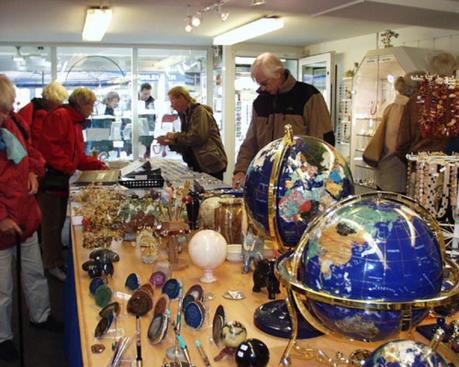
Lapis Lazuli a magical stone that did not stay in the past. Human kind still does wonders with this sacred stone. From jewelry to cloth, from makeup to alternative medicine. Incredible house decorations and even silverware are the fascinating lapis lazuli uses..
Lapis Lazuli is generally known of its use as a gemstone. It is a very popular material for cutting into cabochons and beads for lapis rings, necklaces and bracelets. It is also used in inlay or mosaic projects carving sculptures and other ornamental implements, such as vases and cups. Other popular cuts include round or oval shapes as well as Lapis hearts and trillions.
Jewelry
Today, jewelry is its predominant use. Lapis Lazuli is frequently set in silver in modestly priced jewelry pieces. There is a growing trend to imitate the jewelers of ancient times and set fine-quality stones in gold, complementing diamonds or colored gems.
Lapis is made into cufflinks, pendants, earrings, rings, set into watch faces and inlaid onto clocks. Lapis jewelry has come a long way since the first jewel when a Neolithic man bored a hole through the lapis and strung the pebbles of blue with a thread.
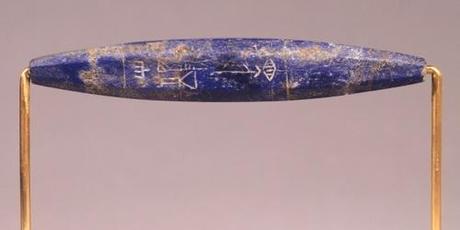
The most popular lapis has a uniform, deep blue to violet blue color. A lot of people enjoy a few randomly placed grains of gold pyrite or a few fractures or mottles of white calcite. Still, when pyrite or calcite is present in more than minor amounts, the allure of the material and the value are significantly lowered. Gray inclusions or mottling also quickly lowers desirability.
Lapis Lazuli has a hardness of about 5.5 on the Mohs Hardness scale which makes this rock especially good to use in earrings, pins, and pendants, where abrasion is less likely to occur. When lapis is used in rings, cuff links or bracelet, especially if the top of the stone is raised above the top of the setting or bezel. In these uses, lapis will show signs of abrasion with continued use.
When stored as unmounted stones or in jewelry, lapis can be damaged if the pieces are not isolated from one another. Jewelry is best stored in separate boxes or bags, or in trays with separate compartments for each item. You can find detailed information on how to clean and store your lapis in Lapis Lazuli Care and Cleaning.

After it is cut and before it is sold as a finished gemstone, sculptures, or ornaments, Lapis Lazuli is frequently treated. Much of the material that enters the market has been treated with wax or oil that improves the luster of polished surface and seal the dyed calcite.
Crystal healing has been around since the beginning of time. It is said that all crystals have healing properties but Lapis Lazuli is a special stone. The gods worshiped Lapis so its power must come from a higher being (if that is possible). To learn more about crystal healing check out Lapis Lazuli Chakra Healing.

Even today Moroccan women are said to use powdered lapis for tattoos.
Tiles and House Decoration
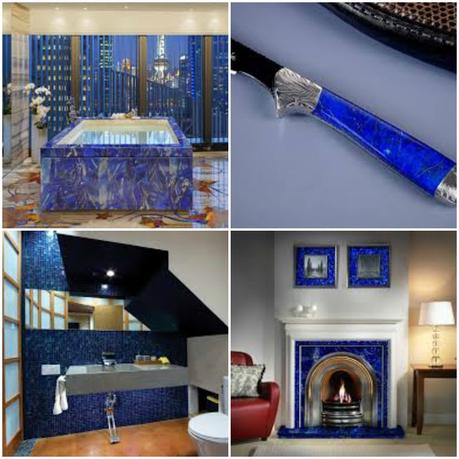
More luxurious than marble! More striking than any ceramic! Dress you walls, tables or counter tops with a semiprecious gemstone.
The large size of the lazurite crystals, with irregular and angular shapes, react to light like finely faceted small diamonds, thereby producing an ever-changing display of rich, vibrant blues. This creates a three dimensional gem-like effect that can be placed on any surface, like a regular tile. The lapis lazuli uses in house decorations are unlimited.
It is incredible how Lapis Lazuli continues to be part of our every day life. From tiles for the living room, bathrooms, kitchen or even our silverware has Lapis Lazuli.
Fashion
Lapis Lazuli is well suited for men´s jewelry because of its rich, blue color. It can often be found in shirt studs and tie tacks, and especially in large cabochon rings. You can check Lapis Lazuli Revolutionizing Fashion to find people going the extra mile to satisfy demanding customers who are only accustomed to the best lapis lazuli linen. Companies like Scabal, Blaak or Linnet have no limits when they create with gems like Lapis Lazuli.

Pantone Color Institute
On September 16, 2016, Pantone LLC and X-Rite Company announced the PANTONE Fashion Color Report Spring 2017 edition. They are the global authority on color and provider of professional color standards for the design industry. And guess which color Pantone has predicted will be one of spring 2017’s hottest color? You guessed it, our magical Lapis Lazuli Blue. So be prepared and trendy and Buy Lapis Lazuli for this spring 2017.
Lapis Lazuli uses has been seen everywhere from furniture to shoes to even buildings like in the old times when it was used in the foundations of important churches and temples.
Makeup
Precious stones like Lapis Lazuli are also used by the famous makeup brands in the world. This shade of blue is called Ultramarine Blue (UMB) and it is derived from Lapis Lazuli. The firt to use Lapis Lazuli makeup were the Egyptian Queens and kings.
The inorganic pigments are no more than that: minerals and metals. This pigment is known to be safe, stable and non-toxic due that it does not have much heavy metal and does not react much with the skin. It has a reduced palette so its use is limited to certain tones. Especially for foundations makeup and blush but not for eye shadows, nail polish and lipsticks. Much of the companies that use lapis are based in the formula that renaissance artists used for the lapis lazuli pigment making.
Rituals
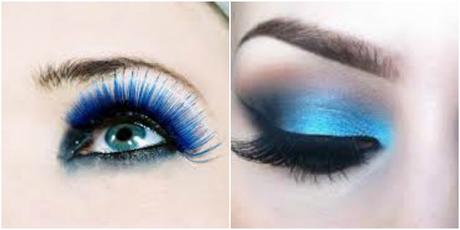
The company Rituals specializes in body lotions and also in makeup using 100% precious gems. They have mastered an ancient craft and made it their own with their unique touch. To learn more about lapis makeup check out Lapis Lazuli Blue fashion.
Kids Learning of Lapis Lazuli
Minecraft
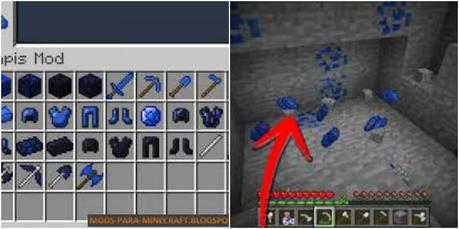
Our young ones are also learning about Lapis Lazuli. First with a game called Minecraft. In Minecraft the mineral Lapis Lazuli gives resources once it is mined. It issued dyes and it was used to make enchantments.
Steven Universe
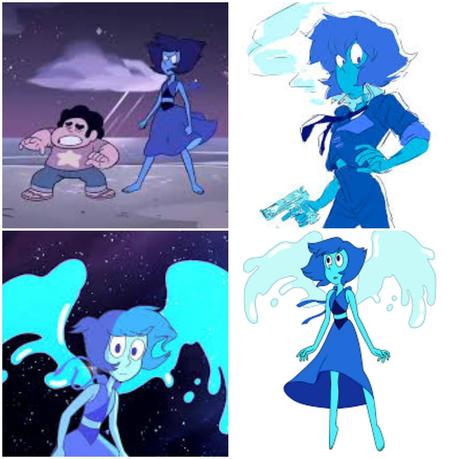
There is another place where are kids are learning about our our beloved lapis. In a TV show called Steven Universe, where lapis is one of the heroes with Steven.
Everything starts in ancient times and is modernized today, but the basics were created by our ancestors. Incredible things, done with an incredible stone…
